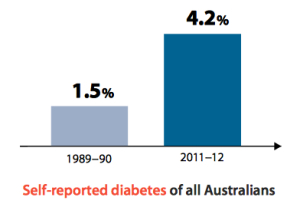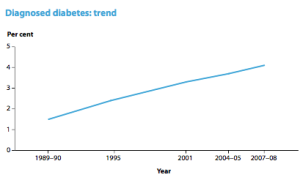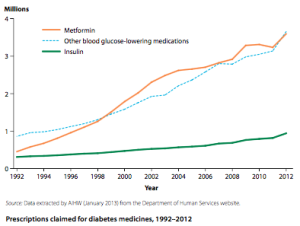The nature of the problem
Diabetes is a disease that relates to the bodies ability to control blood sugar levels using insulin. There are 3 main types: Type 1, type 2 and gestational. Type 1 is also referred to as early onset diabetes and is an autoimmune disorder. Type 1 is when the body no longer produces insulin to control blood sugar levels. People with type 1 require insulin injections in order to control blood sugar levels. Type 1 is often thought to be caused by a combination of genetic predisposition and environmental factors.
Type 2 diabetes on the other hand is characterised by a breakdown in the efficiency of insulin. It is often pictured as a lock and key model, where insulin is the key and the bodies cells have a lock on the door that allows sugar into them. With type 2 the key and lock don’t work properly, which leaves blood sugar levels high and the body releases more insulin in the hope of reducing some of the blood sugar. Type 2 is very lifestyle related and is caused by: physical inactivity, high sugar diet, hypertension, obesity, smoking and high blood lipids.
Gestational diabetes is similar to type 2, but occurs during pregnancy. It is linked with type 2 diabetes, with many women who are diagnosed with it being diagnosed with type 2 soon after childbirth. Gestational diabetes is a risk factor for complications during labour and is connected with a larger birth-weight.
Diabetes can be the underlying cause of other chronic diseases such as: heart disease, liver disease, blindness and limb amputation. Diabetes causes 1 in 3 new cases of end-stage kidney disease
Extent of the problem (trends)
There are 1 million people in Australia with diagnosed diabetes, and another ¼ of people are believed to be undiagnosed. 85% of these cases are type 2 and only 12% are type 1. Over the last 20 years the rate has doubled in Australia to 4.2%.
92% of type 2 diabetes occurs in adulthood, though 8% occurs in children. Diabetes is the 6th leading cause of death in Australia, contributing to 10% of deaths. It is the cause of 2.5% of hospitalisations in 2011 and is an expensive disease with over 8.2 million prescriptions being filled for related medication each year.
Risk factors and protective factors
Risk factors include: a family history, obesity, imbalanced diet (high sugar, fats or alcohol), physical inactivity, smoking, polycystic ovarian syndrome, gestational diabetes, and hypertension.
Protective factors include: good management of blood sugar levels (especially in type 1), regular physical activity, well balanced diet, managing blood pressure, and not smoking.
The sociocultural, socioeconomic and environmental determinants
Sociocultural determinants include: family, peers, media, religion and culture. People who have Chinese, Indian, Pacific Island or ATSI backgrounds are more likely to be diagnosed with type 2. Along with these cultures, families that have poor diets, and sedentary lifestyles are more likely to produce children who grow up to be similar, increasing the likelihood of diagnosis.
Education, employment and income are the socioeconomic determinants. In Australia, people with low socioeconomic status have higher rates of smoking, alcohol consumption, imbalanced diets, obesity, and physical inactivity. This contributes t their higher rates of type 2.
Environmental determinants include geographical location, housing and access to technology and health services. People outside of major cities are more likely to be diagnosed with type 2 diabetes.
Groups at risk
The main groups at risk are those who have a family history. Along with this group; ATSI are 3 times more likely to have diabetes, Pacific Islanders, and people from Chinese or Indian backgrounds are more likely to be diagnosed with type 2 diabetes. Type 2 is more common in men than women, amongst people of low socioeconomic status, and people living outside major cities. Type 2 diabetes is also more prevalent in the elderly, affecting 15% of people over 65 than other Australians.




